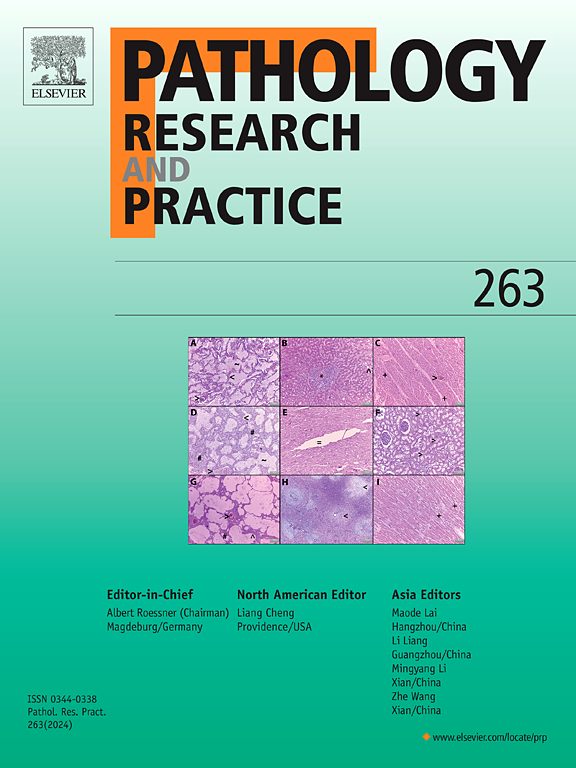Clinicopathological features and prognostic insights of cutaneous versus non-cutaneous angiosarcoma: A retrospective single-center cohort study
IF 3.2
4区 医学
Q2 PATHOLOGY
引用次数: 0
Abstract
Introduction
Angiosarcoma is a rare, aggressive malignancy of endothelial origin, accounting for 1–2 % of soft tissue sarcomas. It occurs in cutaneous (C-AS) and non-cutaneous (NC-AS) forms, with distinct clinical behaviors and prognoses. While C-AS primarily affects the head and neck, NC-AS involves visceral organs such as the heart, liver, and breast. Despite advances in treatment, survival remains poor, and recurrence is common.
Methods
This retrospective, single-center cohort study analyzed 30 patients diagnosed with angiosarcoma at the University Hospital Zurich (2000–2023). The study compared clinicopathological characteristics, survival outcomes, and prognostic factors influencing survival and recurrence. Patients were stratified into C-AS (n = 10) and NC-AS (n = 20) groups. Overall survival (OS) and recurrence-free survival (RFS) were assessed using Kaplan-Meier and Cox regression analyses.
Results
Both subtypes shared a poor prognosis, with an overall 5-year survival rate of 12 %. NC-AS had a higher early mortality rate, with a significantly worse median OS (9 vs. 36 months, p = 0.04), while early recurrence after treatment was more frequent in C-AS. High-grade tumor differentiation and metastases at diagnosis were independent predictors of poorer OS (p = 0.01; p = 0.04). Multimodal treatment, including surgery and radiotherapy, was associated with improved survival (p < 0.05). No clinicopathological factor showed a statistically significant association with RFS.
Conclusion
C-AS and NC-AS exhibit distinct prognostic profiles, with NC-AS associated with a higher metastatic burden and worse outcomes. Prognostic factors such as tumor grade and metastases at diagnosis influence survival. Multimodal treatment strategies appear beneficial, though recurrence remains a major challenge. Further prospective studies are needed to refine therapeutic approaches and explore emerging targeted therapies.
皮肤与非皮肤血管肉瘤的临床病理特征和预后:一项回顾性单中心队列研究
血管肉瘤是一种罕见的、侵袭性的内皮源性恶性肿瘤,占软组织肉瘤的1 - 2% 。它发生在皮肤(C-AS)和非皮肤(NC-AS)形式,具有不同的临床行为和预后。C-AS主要累及头部和颈部,而NC-AS累及内脏器官,如心脏、肝脏和乳房。尽管治疗取得了进展,但生存率仍然很低,而且复发很常见。方法本回顾性、单中心队列研究分析了苏黎世大学医院2000-2023年诊断为血管肉瘤的30例患者。该研究比较了临床病理特征、生存结果以及影响生存和复发的预后因素。将患者分为C-AS组(n = 10)和NC-AS组(n = 20)。采用Kaplan-Meier和Cox回归分析评估总生存期(OS)和无复发生存期(RFS)。结果两种亚型预后均较差,总5年生存率为12. %。NC-AS的早期死亡率更高,中位OS明显更差(9个月vs 36个月,p = 0.04),而C-AS治疗后早期复发更频繁。高级别肿瘤分化和诊断时转移是较差OS的独立预测因素(p = 0.01; = 0.04页)。包括手术和放疗在内的多模式治疗与生存率提高相关(p <; 0.05)。没有临床病理因素显示与RFS有统计学意义的关联。c - as和NC-AS表现出不同的预后特征,NC-AS与更高的转移负担和更差的预后相关。预后因素如肿瘤分级和诊断时的转移影响生存。多模式治疗策略似乎是有益的,尽管复发仍然是主要的挑战。需要进一步的前瞻性研究来完善治疗方法并探索新兴的靶向治疗方法。
本文章由计算机程序翻译,如有差异,请以英文原文为准。
求助全文
约1分钟内获得全文
求助全文
来源期刊
CiteScore
5.00
自引率
3.60%
发文量
405
审稿时长
24 days
期刊介绍:
Pathology, Research and Practice provides accessible coverage of the most recent developments across the entire field of pathology: Reviews focus on recent progress in pathology, while Comments look at interesting current problems and at hypotheses for future developments in pathology. Original Papers present novel findings on all aspects of general, anatomic and molecular pathology. Rapid Communications inform readers on preliminary findings that may be relevant for further studies and need to be communicated quickly. Teaching Cases look at new aspects or special diagnostic problems of diseases and at case reports relevant for the pathologist''s practice.

 求助内容:
求助内容: 应助结果提醒方式:
应助结果提醒方式:


